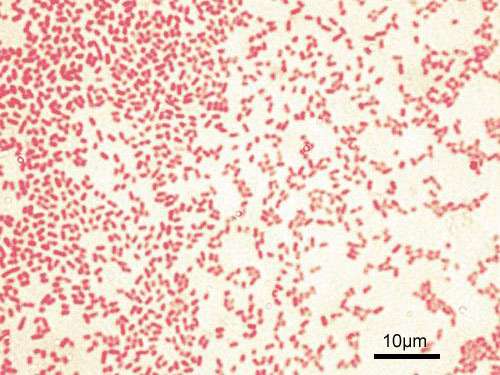This article has been reviewed according to Science X's editorial process and policies. Editors have highlighted the following attributes while ensuring the content's credibility:
fact-checked
trusted source
proofread
Researchers thwart resistant bacteria's strategy

Antibiotic resistant bacteria are experts in evolving new strategies to avoid being killed by antibiotics. One such bacterium is Pseudomonas aeruginosa, which is naturally found in soil and water, but also hospitals, nursing homes and similar institutions for persons with weakened immune systems are home for strains of this bacterium.
As many P. aeruginosa strains found in hospitals are resistant to most antibiotics in use, science is forced to constantly search for new ways to kill them.
Now, at team of researchers from Department of Biochemistry and Molecular Biology and Department of Clinical Microbiology, University of Southern Denmark, have discovered a weakness in P. aeruginosa with the potential to become the target for a new way to attack it.
The team has published their findings in the journal Microbiology Spectrum.The authors are Clare Kirkpatrick, Magnus Z. Østergaard, Flemming D. Nielsen and Mette H. Meinfeldt.
Thick and slimy biofilm
The team discovered a mechanism, that reduces the formation of biofilm on the surface of P. aeruginosa. The formation of sticky, slimy biofilm is a powerful tool used by bacteria to protect themselves against antibiotics—a trick also used by P. aeruginosa.
"This biofilm can be so thick and gooey that antibiotic cannot penetrate the cell surface and reach its target inside the cell," said Kirkpatrick, head of research at Department of Biochemistry and Molecular Biology, adding, "Maybe one day, we could pharmacologically stimulate this mechanism to reduce biofilm development on the surface of P. aeruginosa."
Three new genes
Specifically, the researchers worked with three newly discovered genes in a lab-grown strain of P. aeruginosa. When they overexpressed these genes, they saw a strong reduction of biofilm. Of significance is that the system affected by the genes is part of the P. aeruginosa core genome, meaning that it is universally found in all the P. aeruginosa strains sequenced so far.
"Being part of P. aeruginosa's core genome, this system has been found in all investigated strains of P. aeruginosa, including a large variety of strains isolated from patients. So, there is reason to believe that reduction of biofilm via this system should be effective in all known strains of P. aeruginosa," said Kirkpatrick.
Bacteria strains can evolve individually and mutate quickly and constantly when they are under pressure. It is not uncommon for patients infected with a P. aeruginosa strain to initially respond well to antibiotic treatment but then become resistant as the strain evolves resistance during treatment. Strains mutate, but their common core genome does not change.
Stressing the cell wall
In their experiments, the researchers activated the biofilm reducing system by overexpressing genes. But they also discovered that the system is naturally stimulated by cell wall stress.
"So, if we stress the cell wall, it may naturally lead to a reduction in biofilm, making it easier for antibiotic to penetrate the cell wall," said Kirkpatrick, adding, "Currently, cell wall-targeted drugs are not widely used against P. aeruginosa, but perhaps, they could start to be used as additives to help reduce biofilm production and improve access of the existing antibiotics to the cells."
Bacteria cell wall is very different from human cell wall
When combating infectious bacteria, there are only a limited number of targets to attack. Targets found in both bacterial and human cells cannot be attacked, as the antibiotics would also affect human cells.
Bacterial cells and human cells have some targets in common, such as the process that replicates DNA and the processes controlling basic glucose metabolism or respiration in cells.
Among the targets unique to bacteria are various protein functions and also the bacterial cell wall is considered a suitable target, as it is very different from the human cell wall.
More information: The uncharacterized PA3040-3042 operon is part of the cell envelope stress response and a tobramycin resistance determinant in a clinical isolate of Pseudomonas aeruginosa", Microbiology Spectrum (2024). DOI: 10.1128/spectrum.03875-23. journals.asm.org/doi/10.1128/spectrum.03875-23
Provided by University of Southern Denmark




















